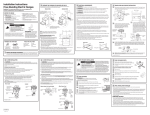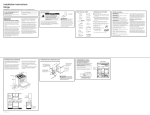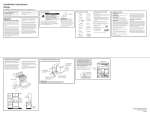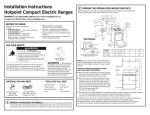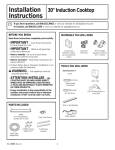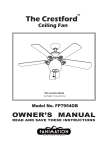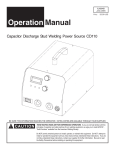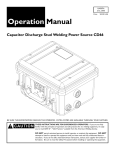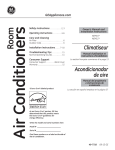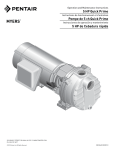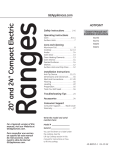Download GE PS950EFES Instructions / Assembly
Transcript
Installation Instructions
Slide-In Electric Ranges
See illustrations for all rough-in and spacing dimensions. The range may be placed with 0”
clearance (flush) at the back wall and side walls of the cabinet.
Questions? Call 1.800.GE.CARES (1.800.432.2737) or visit www.GEAppliances.com
In Canada, call 1.800.561.3344 or visit www.GEAppliances.ca
21ø2”
Read these instructions completely and carefully.
IMPORTANT³Save these instructions
for local inspector’s use.
IMPORTANT³ Observe all
governing codes and ordinances.
1RWHWR,QVWDOOHU²%HVXUHWROHDYHWKHVH
instructions with consumer.
Unit will not mount flush
to counter when heights
are less than 36”.
1RWHWRFRQVXPHU².HHSWKHVH
instructions for future reference.
6NLOOOHYHO²,QVWDOODWLRQRIWKLVDSSOLDQFH
requires a qualified installer or electrician.
3URSHULQVWDOODWLRQis the responsibility of the
installer.
3URGXFWIDLOXUHGXHWRLPSURSHULQVWDOODWLRQLV
not covered under warranty.
297ø8”
WARNING³ %HIRUH
Squeeze Connector
(For Conduit
Installations Only)
8//LVWHG$03
4-Wire Cord 4’ long OR
3-Wire Cord 4’ long
beginning the installation, switch
power off at service panel and lock
the service disconnecting means to
prevent power from being switched
on accidentally. When the service
disconnecting means cannot be
locked, securely fasten a prominent
warning device, such as a tag, to the
service panel.
TOOLS YOU WILL NEED
'ULOOZLWKµ%LW
Safety Glasses
Adjustable Wrench
Level
Tin Snips
Tape Measure
3OLHUV
1/4” Nut Driver
5/16” Nut Driver
1 REMOVE PACKAGING MATERIALS: Failure to remove packaging materials
could result in damage to the appliance. Remove all packing parts from oven, racks, heating
elements and drawer. Also, remove protective film and labels on the outer door, cooktop and
control panel.
5 3-WIRE INSTALLATION
WARNING: The neutral or ground wire of the power cord must be connected to the neutral
terminal located in the center of the terminal block and the ground strap must connect the neutral terminal
to the ground plate. The power leads must be connected to the lower left and the lower right terminals of the
terminal block.
DO NOT remove the ground strap connection.
FOR POWER CORD INSTALLATION
A. Remove the 3 lower terminal screws from the terminal block.
%,QVHUWWKH3 terminal screws through each power cord terminal ring and into the lower terminals of
WKHWHUPLQDOEORFN%HFHUWDLQWKDWWKHFHQWHUZLUHZKLWHQHXWUDOLVFRQQHFWHGWRWKHFHQWHUORZHU
position of the terminal block.
C. Tighten screws securely into the terminal block.
FOR CONDUIT INSTALLATION
A. Loosen the 3 lower terminal screws on the terminal block. Strip wire to exposed tip about 5/8” long.
%Insert the center (white/neutral) wire tip through the bottom center terminal block opening. On certain
models, the wire will need to be inserted through the ground strap opening and then into the bottom
center block opening. Insert the two side bare wire tips into the lower left and the lower right terminal
block openings.
C. Tighten the screws until the wire is firmly secured (35 to 50 inch-lbs.). Do not over-tighten the screws.
NOTE: ALUMINUM WIRING: Aluminum building wire may be used but it must be rated for the correct
amperage and voltage.
3RZHU&RUG
Terminal block
(appearance
may vary)
Neutral terminal
Wire tips
Ground strap
257ø8”
451ø8”
MINIMUM DIMENSIONS BETWEEN COOKTOP,
WALLS AND ABOVE THE COOKTOP:
A. Make sure the wall covering, countertop, flooring
and cabinets around the range can withstand the
heat (up to 200°F) generated by the range.
%$OORZµPLQLPXPFOHDUDQFHEHWZHHQVXUIDFH
units and bottom of unprotected wood or metal
cabinet, or allow a 24” minimum when bottom
of wood or metal cabinet is protected by no less
than 1/4” thick flame retardant millboard covered
with not less than No 28 MSG sheet metal, (.015”),
.015” thick stainless steel, .024”
aluminum or .020” copper.
Conduit
SINGLE OVEN
DOUBLE OVEN
A
Rating plate
A
Rating plate
FOR POWER CORD INSTALLATION
A. Remove the 3 lower terminal screws from the terminal block. Remove the ground screw and ground
plate and retain them. Cut and discard the ground strap. DO NOT DISCARD ANY SCREWS.
% Insert the one ground screw into the power cord ground wire terminal ring, through the ground plate
and into the frame of the range.
C. Insert the 3 terminal screws (removed earlier) through each power cord terminal ring and into the lower
WHUPLQDOVRIWKHWHUPLQDOEORFN%HFHUWDLQWKDWWKHFHQWHUZLUHZKLWHQHXWUDOLVFRQQHFWHGWRWKHFHQWHUORZHU
position of the terminal block. Tighten screws securely into the terminal block.
FOR CONDUIT INSTALLATION
A. Loosen the 3 lower terminal screws on the terminal block. Remove the ground screw and ground plate and
retain them. Cut and discard the ground strap. DO NOT DISCARD ANY SCREWS. Strip wire to exposed tip
about 5/8” long.
% Insert the ground bare wire tip between the range frame and the ground plate (removed earlier)
and secure it in place with the ground screw (removed earlier). Insert the bare wire (white/neutral) tip through
the bottom center of the terminal block opening. Insert the two side bare wire tips into the lower left and the
lower right terminal block openings.
C. Tighten the screws until the wire is firmly secured (35 to 50 inch-lbs.). Do not over-tighten the screws.
NOTE: ALUMINUM WIRING: Aluminum building wire may be used but it must be rated
for the correct amperage and voltage.
After–Power Cord
Ground strap
Ground
strap
Neutral
terminal
.QRFNRXW
ring in
bracket
For power cord installations only (see the
next step if using conduit), assemble the
strain relief in the hole. Insert the power
cord through the strain relief and tighten.
Allow enough slack to easily attach the
cord terminals to the terminal block. If tabs
are present at the end of the winged strain
relief, they can be removed for better fit.
NOTE: Do not install the power cord without
a strain relief. The strain relief bracket MUST
be installed before reinstalling the rear range
wiring cover.
Strain relief
Terminal
block
%UDFNHW
Terminal
block
Neutral
terminal
Ground plate
(grounding to
range)
Ground
screw
Conduit
Terminal
block
Wire
tips
Terminal block
%UDFNHW
PROCEED TO STEP 5 OR 6.
Replace wire cover on range back by sliding its left edge under the retaining tabs and replace the
screws removed earlier. Make sure that no wires are pinched between cover and range back.
%DFNRIUDQJH
%DFNRIUDQJH
Screw to
remove
terminal
block cover
Screw to
remove
terminal
block cover
Terminal
block cover
Terminal
block cover
8 ANTI-TIP DEVICE INSTALLATION
To reduce the
risk of tipping
the range, the
range must be
Tip-Over Hazard
secured by a
A child or adult can tip the range and be killed.
properly installed
Verify the anti-tip bracket has been properly installed
anti-tip bracket.
and engaged.
See installation
Ensure the anti-tip bracket is re-engaged when the range instructions
is moved.
shipped with
Do not operate the range without the anti-tip bracket in the bracket
for complete
place and engaged.
Failure to follow these instructions can result in death or details before
attempting to
serious burns to children or adults.
install.
To check if the bracket is installed and engaged properly, look underneath the range to see that the leveling
leg is engaged in the bracket. On some models, the storage drawer or kick panel can be removed for easier
inspection. If visual inspection is not possible, slide the range forward, confirm the anti-tip bracket is securely
attached to the floor or wall, and slide the range back so the leveling leg is under the anti-tip bracket. If the
range is pulled from the wall for any reason, always repeat this procedure to verify the range is properly
secured by the anti-tip bracket. Never completely remove the leveling legs or the range will not be secured to
the anti-tip device properly.
WARNING
9 LEVEL THE RANGE
9 LEVEL THE RANGE (CONT.)
G
3RVLWLRQFRUGVRWKDWLWGRHVQRWLQWHUIHUHZLWKGUDZHU
3ODFHGUDZHUUDLORQJXLGHV3XVKWKHGUDZHULQXQWLOLWVWRSV
H
Lift front of drawer and push in until the stops clear
the guides.
I
Lower the front of the drawer and push in until it closes.
Leg
leveler
MODELS WITH BAKING, WARMING DRAWERS OR DOUBLE OVEN
A
3OXJLQWKHXQLW
B
Measure the height of your countertop at the rear of the opening.
Raise
range
C
Adjust two rear leveling legs so that the rear of cooktop is at the same height as the counter.
D
E
Slide unit into place.
F
Check for levelness by placing a spirit level on one of the oven shelves.
7DNHWZRUHDGLQJV³ZLWKWKHOHYHOSODFHGGLDJRQDOO\ILUVWLQRQHGLUHFWLRQ
and then the other.
G
Adjust front leveling legs until the range is level.
Install oven shelves in the oven and position the range where it will be installed.
10 FINAL INSTALLATION CHECKLIST
&KHFNWRPDNHVXUHWKHFLUFXLWEUHDNHULVFORVHG5(6(7RUWKHFLUFXLWIXVHVDUHUHSODFHG
%HVXUHSRZHULVLQVHUYLFHWRWKHEXLOGLQJ
&KHFNWKDWDOOSDFNLQJPDWHULDOVDQGWDSHKDYHEHHQUHPRYHG7KLVZLOOLQFOXGHWDSHRQPHWDOSDQHOXQGHU
control knobs (if applicable), adhesive tape, wire ties, cardboard and protective plastic. Failure to remove
these materials could result in damage to the appliance once the appliance has been turned on and
surfaces have heated.
&KHFNWKDWWKHGRRUDQGGUDZHUDUHSDUDOOHOWRHDFKRWKHUDQGWKDWERWKRSHUDWHVPRRWKO\,IWKH\
do not, see the Owner’s Manual for proper replacement.
&KHFNWRPDNHVXUHWKDWWKHUHDUOHYHOLQJOHJLVIXOO\LQVHUWHGLQWRWKH$QWL7LSEUDFNHWDQGWKDWWKHEUDFNHW
is securely installed.
OPERATION CHECKLIST
WARNING: Never completely remove the leveling leg
as the range will not be secured to the anti-tip device properly.
02'(/6:,7+6725$*('5$:(525.,&.3$1(/6
Ground
plate
(grounding
to range)
For 3/4” conduit installations only, purchase a squeeze connector matching the diameter of your
conduit and assemble it in the hole. Insert the conduit through the squeeze connector and tighten.
Allow enough slack to easily attach the wires to the terminal block. NOTE: Do not install the conduit
without a squeeze connector. The squeeze connector MUST be installed before reinstalling the rear
range wiring cover.
Squeeze
connector
WARNING: The neutral wire of the supply circuit must be connected to the neutral terminal
located in the lower center of the terminal block. The power leads must be connected to the lower left and the
lower right terminals of the terminal block. The grounding lead must be connected to the frame of the range with
the ground plate and the green ground screw.
or
Terminal block
(appearance
may vary)
D
7 REPLACE THE WIRE COVER
6 4-WIRE INSTALLATION
Terminal
block
C
For power cord and 1” conduit only, remove the
knockout ring (13ø8”) located on bracket directly
below the terminal block. To remove the
knockout, use a pair of pliers to bend the
knockout ring away from the bracket and
twist until ring is removed.
.QRFNRXWULQJ
removed
C. This appliance has been approved for 0” spacing to adjacent surfaces above the cooktop. However, a
6” minimum spacing to surfaces less than 15” above the cooktop and adjacent
cabinet is recommended to reduce exposure to steam, grease splatter and heat.
To reduce the risk of burns or fire when reaching over hot surface elements, cabinet storage space
above the cooktop should be avoided. If cabinet storage space is to be provided above
the cooktop, the risk can be reduced by installing a range hood that projects at least 5” beyond
the front of the cabinets. Cabinets installed above the cooktop must be no deeper than 13”.
Before–Power Cord and Conduit
B
3RZHUFRUG
Ground screw
01-12 GE
Use only a 3-conductor or a 4-conductor UL-listed range cord. These cords may be provided with ring
terminals on wire and a strain relief device.
C
%RWK
Sides
NOTE C
Terminal block cover
This appliance must be supplied with the proper voltage and frequency, and connected to an individual,
properly grounded, 40 amp (minimum) branch circuit protected by a circuit breaker or time-delay fuse.
The rating plate is located on the oven frame or on the side of the drawer frame.
%
PROCEED TO STEP 7.
31-10769-3
Check with your local utilities for electrical codes which apply in your area. Failure to wire your oven
according to governing codes could result in a hazardous condition. If there are no local codes, your
RYHQPXVWEHZLUHGDQGIXVHGWRPHHWWKH1DWLRQDO(OHFWULFDO&RGH1)3$1R²ODWHVWHGLWLRQ
DYDLODEOHIURPWKH1DWLRQDO)LUH3URWHFWLRQ$VVRFLDWLRQ
Screw to
remove
terminal
block cover
Terminal
block cover
Effective January 1, 1996, the National Electrical Code requires that new construction (not existing) utilize
a 4-conductor connection to an electric range. When installing an electric range in new construction,
mobile home, recreational vehicle, or an area where local codes prohibit grounding through the neutral
conductor, refer to the section on four-conductor branch circuit connections.
A range cord rated at 40 amps with 125/250 minimum volt range is required. A 50 amp range cord is not
UHFRPPHQGHGEXWLIXVHGLWVKRXOGEHPDUNHGIRUXVHZLWKQRPLQDOøµGLDPHWHUFRQQHFWLRQRSHQLQJV
Care should be taken to center the cable and strain relief within the knockout hole to keep the edge from
damaging the cable.
NOTE: Use a 4’ power cord to prevent interference with
the storage drawer. Power cords 41ø2’ to 6’ long may
have to be dressed to allow for proper drawer closing.
After–Conduit
Ground
plate
3RZHUFRUG
36”
DOUBLE OVEN
Conduit
Terminal
block
You must use a single-phase, 120/208 VAC or 120/240 VAC, 60 hertz electrical system. If you connect to
aluminum wiring, properly installed connectors approved for use with aluminum wiring must be used.
371ø4”
SINGLE OVEN
Screw to
remove
terminal
block cover
We recommend you have the electrical wiring and hookup of your range connected by a qualified
electrician. After installation, have the electrician show you how to disconnect power from the range.
311ø4”
297ø8”
481ø4”
Tip-Over Hazard
A child or adult can tip the range and be killed.
Verify the anti-tip bracket has been properly installed
and engaged.
Ensure the anti-tip bracket is re-engaged when the range
is moved.
Do not operate the range without the anti-tip bracket in
place and engaged.
Failure to follow these instructions can result in death or
serious burns to children or adults.
MATERIALS YOU MAY NEED
7ø”
3”
Remove wire cover (on the back of range) by removing screws using a 1/4” nut driver. You can
access the terminal block by either removing a terminal block cover (on some models) or the
wire cover. Do not discard these screws.
%DFNRIUDQJH
%DFNRIUDQJH
installation.
297ø8”
Acceptable electrical
36”
outlet area. Orient
electrical receptacle so
1
37 ø4” the length is parallel to
floor.
Use a flush mount outlet
for double oven models.
257ø8”
WARNING
If you did not receive an anti-tip bracket with your purchase,
call 1.800.626.8774 to receive one at no cost. (In Canada,
call 1.800.561.3344.) For installation instructions of the bracket,
visit: www.GEAppliances.com. (In Canada, www.GEAppliances.ca.)
or warming drawers,
electrical outlet must not
be in this area.
12
31 ø ”
WARNING:To prevent fire or shock, do not use an extension cord with this appliance.
WARNING: To prevent shock, remove house fuse or open circuit breaker before beginning
21ø2” On models with baking
141ø2”
14
A
local codes do not allow grounding through neutral, require a 4-conductor UL-listed range cord.
297ø8”
FOR YOUR SAFETY:
$QWL7LS%UDFNHW
.LW,QFOXGHG
7”
4 POWER CORD AND CONDUIT INSTALLATION
WARNING: This appliance must be properly grounded.
WARNING: All new constructions, mobile homes, recreational vehicles and installations where
30”
25”
BEFORE YOU BEGIN
3 ELECTRICAL REQUIREMENTS
2 PREPARE THE OPENING (FOR INDOOR USE ONLY)
Stop
A
B
3OXJLQXQLWDQGVOLGHLQWRSODFH3XOOGUDZHURXWXQWLOLWVWRSV
C
Install the oven shelves in the oven and position the range where
it will be installed.
D
Check for levelness by placing a spirit level on one of the oven shelves.
7DNHWZRUHDGLQJV³ZLWKWKHOHYHOSODFHGGLDJRQDOO\ILUVW
in one direction and then the other.
E
The front leveling legs can be adjusted from the bottom
and the rear legs can be adjusted from the top or the bottom.
F
Use an adjustable wrench to adjust the leveling legs until the range is level.
Lift front of drawer until the stops clear the guide. Remove the drawer.
Spirit level
Turn on one of the surface units to observe that the element glows within 60 seconds. Turn the unit
off when glow is detected. If the glow is not detected within the time limit, recheck the range wiring
connections. If change is required, retest again. If no change is required, have building wiring checked for
proper connections and voltage.
&KHFNWKDWWKH&ORFNRQPRGHOVVRHTXLSSHGGLVSOD\LVHQHUJL]HG,IDVHULHVRIKRUL]RQWDOUHG
lines appear in the display, disconnect power immediately. Recheck the range wiring connections.
If change is made to connections, retest again. If no change is required, have building wiring checked for
proper connections and voltage. It is recommended that the clock be changed if the red lines appear.
%HVXUHDOOUDQJHFRQWUROVDUHLQWKH2))SRVLWLRQEHIRUHOHDYLQJWKHUDQJH
Instrucciones de instalación
Cocinas empotrables eléctricas
2
¿Preguntas? Llamada 1.800.GE.CARES (1.800.432.2737) o visita www.GEAppliances.com
CÓMO PREPARAR LA ABERTURA (PARA USO EN EL INTERIOR SOLAMENTE)
Ver ilustraciones con todas las dimensiones de empotrado y de espacio. La cocina puede ubicarse con un
espacio de 0” (alineado) sobre la pared trasera y las paredes laterales del gabinete.
21ø2”
(6,4 cm)
En Canadá, llame 1.800.561.3344 o visita www.GEAppliances.ca
ANTES DE COMENZAR
Lea estas instrucciones por completo y con
detenimiento.
IMPORTANTE ³Guarde estas
instrucciones para el uso de inspectores locales.
IMPORTANTE ³ Siga todos los códigos
y ordenanzas vigentes.
1RWDDOLQVWDODGRU²$VHJ~UHVHGHGHMDUHVWDV
instrucciones con el consumidor.
25”
(63,5 cm)
1RWDDOFRQVXPLGRU²&RQVHUYHHVWDV
instrucciones para referencia futura.
1LYHOGHGHVWUH]D²/DLQVWDODFLyQGHHVWH
aparato debe efectuarla un instalador o
electricista calificado.
(OLQVWDODGRUWLHQHODUHVSRQVDELOLGDGGH
efectuar una instalación adecuada.
/DJDUDQWtDQRFXEUHODVIDOODVGHOSURGXFto
debido a una instalación incorrecta.
La unidad no se montará al
ras de la estantería cuando
la altura sea inferior a 36”.
Conector de presión
(Sólo para instalaciones
con conductos
portacables)
$SUREDGRVSRU8/GH$03
Cable de 4 alambres de 4’
de largo O Cable de 3 alambres
de 4’ de largo
HERRAMIENTAS NECESARIAS
Cinta métrica
Alicates
Llave de tuercas
de 1/4”
Llave de tuercas
de 5/16”
1
QUITE LOS MATERIALES DE ENVÍO: No quitar los materiales de empaque puede provocar
daños al electrodoméstico. Quite todas las partes de empaque del horno, bandejas, elementos calentadores y
cajón. También, quite la película protectora y las etiquetas de la puerta exterior, estufa y panel de control.
5 INSTALACIÓN DE TRES (3) ALAMBRES
36”
(91,4 cm)
PARA INSTALACIÓN DE CABLE DE ENERGÍA
A. Quite los 3 tornillos inferiores del bloque terminal.
%,QWURGX]FDORVWRUQLOORVGHWHUPLQDODWUDYpVGHFDGDDQLOORGHWHUPLQDOGHFDEOHGHHQHUJtD\
GHQWURGHODVWHUPLQDOHVLQIHULRUHVGHOEORTXHWHUPLQDO$VHJ~UHVHGHTXHHODODPEUHFHQWUDOEODQFR
neutral) se encuentre conectado a la posición central inferior del bloque terminal.
C. Ajuste bien los tornillos al bloque terminal.
PARA INSTALACIÓN DE CONDUCTO PORTACABLES
$$IORMHORVWRUQLOORVLQIHULRUHVGHOEORTXHWHUPLQDO3HOHHOFDEOHGHODSXQWDH[SXHVWDFRQXQD
longitud de 5/8”.
%,QWURGX]FDODSXQWDGHOFDEOHFHQWUDOEODQFRQHXWUDODWUDYpVGHODDEHUWXUDGHOEORTXHWHUPLQDO
central inferior. En algunos modelos, el cable tendrá que introducirse a través de la abertura de la cinta de
conexión a tierra y luego a través de la abertura del bloque central inferior. Introduzca las dos puntas de
cable pelado dentro de las aberturas de bloque terminal izquierda inferior y derecha inferior.
C. Ajuste los tornillos hasta que el cable quede bien firme (35 a 50 pulg-lbs). No ajuste los tornillos de más.
NOTA: CABLEADO DE ALUMINIO: Puede utilizarse cable de construcción de aluminio pero debe clasificarse
para el amperaje y voltaje correctos.
%ORTXHWHUPLQDO
(la apariencia
puede cambiar)
Terminal neutral
Cinta de
conexión a tierra
3ODFDGH
conexión a
tierra
Cable de energía
37 ø ”
(94,6 cm)
14
257ø8”
(65,8 cm)
481ø4”
(122,9 cm)
Conducto portacables
371ø4”
(94,6 cm)
8VWHGGHEHXVDUXQVLVWHPDHOpFWULFRGHKHUFLRV&$GHIDVH~QLFDGHYROWLRVRYROWLRV6L
tiene una conexión con cableado de aluminio, deben utilizarse conectores adecuadamente instalados para
utilizar con cableado de aluminio.
Si el servicio eléctrico provisto no cumple con las especificaciones anteriores, haga que un electricista con
licencia instale un tomacorriente aprobado.
Vigente desde el 1 de enero de 1996, el Código Eléctrico Nacional requiere que las nuevas
construcciones (no existentes) utilicen una conexión de cuatro conductores a una cocina eléctrica. Cuando
instale una cocina eléctrica en una nueva construcción, una casa rodante, un vehículo
recreativo o un área donde los códigos locales prohíben la conexión a tierra a través de un conductor
neutral, consulte la sección sobre conexiones en circuito derivado de cuatro conductores.
&RQVXOWHDODVHPSUHVDVGHVHUYLFLRS~EOLFRVREUHORVFyGLJRVHOpFWULFRVTXHVHDSOLFDQHQVXiUHD1R
realizar el cableado de su horno de acuerdo con los códigos vigentes puede provocar una situación
peligrosa. Si no existen códigos locales, su cocina debe contar con cables y fusibles que cumplan con los
UHTXLVLWRVGHO&yGLJR(OpFWULFR1DFLRQDO$16,1)3$1R²ÒOWLPDHGLFLyQ
Este electrodoméstico debe recibir el voltaje y frecuencia adecuados, y debe conectarse a un circuito
derivado individual con adecuada conexión a tierra de 40 amperios (mínimo) protegido por un
interruptor de circuitos o fusible con retraso.
Utilice sólo un cable para cocinas de 3 o 4 conductores aprobado por UL. Estos cables pueden contar con
terminales de anillo en alambre y un dispositivo de alivio de tensión.
Se requiere un cable para cocinas clasificado para 40 amperios con rango de voltios mínimo de 125/250.
No se recomienda un cable de 50 amperios, pero si se utiliza, debe señalizarse para usarse con aberturas
de conexión de un diámetro nominal de 1-3/8”. Debe tenerse cuidado al centrar el cable y el alivio de
tensión dentro del orificio de expulsión para evitar que el borde dañe el cable.
HORNO SIMPLE
Tornillo
para quitar
la tapa del
bloque
terminal
Tapa del bloque terminal
B
Tapa del bloque terminal
3DUDFDEOHGHHQHUJtD\SDVDFDEOHVGHµ
solamente, quite el anillo de expulsión (1-3/8”)
ubicado en el soporte directamente debajo del
EORTXHWHUPLQDO3DUDTXLWDUHODQLOORXWLOLFHXQSDUGH
alicates para doblar el anillo de expulsión lejos del
soporte y gire hasta remover el anillo.
%ORTXHWHUPLQDO
(la apariencia
puede cambiar)
Anillo de
expulsión
en el
soporte
C
Sólo para instalaciones de cable de energía
(ver el paso siguiente si utiliza un conducto
portacables), instale el alivio de tensión en el orificio.
Introduzca el cable de energía a través del alivio de
tensión y ajuste. Deje un largo suficiente para poder
conectar las terminales de cable al bloque terminal. Si
hay lengüetas al final del alivio de tensión con alas,
éstas pueden quitarse para un ajuste mejor.
NOTA: No instale el cable de energía sin un alivio
GHWHQVLyQ(OVRSRUWHGHODOLYLRGHWHQVLyQ'(%(
instalarse antes de volver a colocar la tapa del
cableado trasero de la cocina.
Alivio de tensión
%ORTXH
terminal
Anillo de
expulsión
quitado
D
La placa de clasificación se encuentra ubicada sobre el cajón de almacenamiento en el marco del horno o
en el lado del marco del cajón.
HORNO DOBLE
Soporte
Cable de
energía
Sólo para instalaciones con conducto
portacables de 3/4”, adquiera un conector de
presión que se ajuste al diámetro de su conducto e instálelo en el orificio. Introduzca el conducto a
través del conector de presión y ajuste. Deje un largo suficiente para poder pegar los cables al
bloque terminal. NOTA: No instale el conducto sin un conector de presión. El conector de presión
'(%( instalarse antes de volver a colocar la tapa del cableado trasero de la cocina.
Conector
de presión
3ODFDGH
clasificación
3ODFDGH
clasificación
Conducto
portacables
Reemplace la tapa de los cables de la cocina deslizando el lado izquierdo bajo las lengüetas de
retención y reemplazando los cinco tornillos quitados anteriormente. Verifique que los cables no hayan
sufrido pellizcos entre la tapa y la parte trasera de la cocina.
Parte trasera de la cocina
Parte trasera de la cocina
ADVERTENCIA: El cable neutral del circuito de suministro debe estar conectado a la
terminal neutral ubicada en el centro inferior del bloque terminal. Los cables de energía deben estar conectados a las
terminales inferior izquierda e inferior derecha del bloque terminal. El cuarto cable a tierra debe estar conectado al
marco de la cocina con la placa de conexión a tierra y el tornillo a tierra.
%ORTXHWHUPLQDO
Soporte
PARA INSTALACIÓN DE CONDUCTO PORTACABLES
A. Afloje los tres tornillos inferiores del bloque terminal. Quite el tornillo a tierra y la placa de conexión a tierra y
FRQVpUYHORV&RUWH\GHVFDUWHODFLQWDGHFRQH[LyQDWLHUUD12(/,0,1(1,1*Ò17251,//2
% Introduzca la punta pelada del cable a tierra entre el marco de la cocina y la placa de conexión a tierra
TXLWDGDDQWHV\DVHJ~UHODHQVXOXJDUFRQHOWRUQLOORGHFRQH[LyQDWLHUUDTXLWDGRDQWHV,QWURGX]FDODSXQWD
pelada del cable (blanco/neutral) a través del centro inferior de la abertura del bloque terminal. Introduzca las dos
puntas de cable pelado dentro de las aberturas de bloque terminal izquierda inferior y derecha inferior.
C. Ajuste los tornillos hasta que el cable quede bien firme (35 a 50 pulg-lbs). No ajuste los tornillos de más.
NOTA: CABLEADO DE ALUMINIO: Puede utilizarse cable de construcción de aluminio pero debe clasificarse
para el amperaje y voltaje correctos para poder realizar la conexión.
Después–Cable de energía
Antes–Cable de energía
y conducto portacables
Cinta de
conexión a tierra
%ORTXH
terminal
%ORTXH
terminal
o
Terminal
neutral
Terminal
neutral
3ODFDGH
conexión a tierra
(conexión a tierra
de la cocina)
Tornillo de
conexión
a tierra
Tornillo de
conexión
a tierra
Tornillo
para quitar
la tapa del
bloque
terminal
Tapa del bloque terminal
Tornillo
para quitar
la tapa del
bloque
terminal
Tapa del bloque
terminal
8 INSTALACIÓN DE DISPOSITIVO ANTI-VOLCADURAS
A fin de reducir el
riesgo de inclinar la
cocina, ésta deberá
Riesgo de Volcaduras
estar asegurada
con un soporte anti
Un niño o adulto pueden volcar la cocina y morir.
volcaduras. Lea
Verifique que el soporte anti-volcaduras se haya
las instrucciones
instalado y ajustado correctamente.
de instalación que
Verifique que el soporte anti-volcaduras se haya
se enviaron con el
instalado y ajustado correctamente.
soporte para obtener
un detalle completo
No utilice la cocina sin que el soporte anti-volcaduras
antes de comenzar
esté colocado y ajustado.
Si estas instrucciones no se siguen, como resultado se podrá la instalación.
producir la muerte o quemaduras graves de niños y adultos. 3DUDFRQWURODUVLHO
soporte es instalado
y ajustado de forma apropiada, mire que debajo de la cocina la pata niveladora trasera esté ajustada al soporte. En algunos
modelos, el cajón de almacenamiento o el panel de protección se pueden retirar para una fácil inspección. Si no es posible
realizar una inspección visual, deslice la cocina hacia adelante, confirme que el soporte anti-volcaduras esté ajustado de
forma segura al piso o la pared, y deslice la cocina hacia atrás de modo que la pata niveladora trasera se encuentre debajo
del soporte anti-volcaduras. Si la cocina es expulsada de la pared por alguna razón, siempre repita este procedimiento a fin
de verificar que esté asegurado de forma correcta con un soporte anti volcaduras. Nunca elimine completamente las patas
niveladoras, ya que de ser así la cocina no estará adecuadamente asegurada por el dispositivo anti volcaduras.
ADVERTENCIA
9 NIVELE LA COCINA
Después–Conducto portacables
3ODFDGH
conexión
a tierra
(conexión a
tierra de la
cocina)
9 NIVELE LA COCINA (CONT.)
G
H
PARA INSTALACIÓN DE CABLE DE ENERGÍA
A. Quite los 3 tornillos inferiores del bloque terminal. Quite el tornillo a tierra y la placa de conexión a tierra y
FRQVpUYHORV&RUWH\GHVFDUWHODFLQWDGHFRQH[LyQDWLHUUD12(/,0,1(1,1*Ò17251,//2
%,QWURGX]FDHOWRUQLOORGHFRQH[LyQDWLHUUDGHQWURGHODQLOORWHUPLQDOGHFRQH[LyQDWLHUUDGHOFDEOHGH
energía, a través de la placa de conexión a tierra y dentro del marco de la cocina.
C. Introduzca los 3 tornillos de terminal (quitados antes) a través de cada anillo de terminal de cable de
HQHUJtD\GHQWURGHODVWHUPLQDOHVLQIHULRUHVGHOEORTXHWHUPLQDO$VHJ~UHVHGHTXHHODODPEUHFHQWUDO
(blanco/neutral) se encuentre conectado a la posición central inferior del bloque terminal. Ajuste bien los
tornillos al bloque terminal.
3XQWDVGH
los cables
GE
Tornillo
para quitar
la tapa del
bloque
terminal
7 REEMPLACE LA TAPA DE LOS CABLES
%ORTXH
terminal
12-11
36”
(91,4 cm)
HORNO DOBLE
SIGA CON EL PASO 7.
31-10769-3
311ø4”
79,375 cm)
7
29 ø8”
75,9 cm
Parte trasera de la cocina
SIGA CON EL PASO 5 O 6.
Cinta de
conexión
a tierra
Conducto
portacables
Parte trasera de la cocina
Recomendamos que un electricista calificado conecte el cableado eléctrico y su cocina. Después
de la instalación, solicite al electricista que le indique cómo desconectar la energía de la cocina.
297ø8”
75,9 cm
NOTA: Utilice un cable de energía de 4’ para evitar una
interferencia con el cajón de almacenamiento. Los cables de
energía de 41ø2’ a 6’ de largo pueden tener que cubrirse para
poder cerrar el cajón correctamente.
**30” Min.
DIMENSIONES MÍNIMAS ENTRE LA ESTUFA, LAS PAREDES Y
***
6”
SOBRE LA PARTE SUPERIOR DE LA ESTUFA:
Min.
**15” Min.
A. Verifique que el revestimiento de las paredes, el
mostrador, el piso y los gabinetes ubicados alrededor de
la cocina puedan soportar el calor (hasta 200°F) generado
por la cocina.
%Deje un espacio de 30” como mínimo entre las unidades
de superficie y la parte inferior de gabinetes de madera o
*0”
*0”
de metal sin protección o deje un mínimo de 24” cuando
la parte inferior del gabinete de madera o metal se
encuentre protegida por cartón aislante de un grosor no
menor a 1/4” y con retardo de llama cubierto con una
placa de metal no menor a MSG Nº 28, acero inoxidable
de un grosor de .015”, aluminio de .024” o cobre de .020”.
C. Este aparato ha sido aprobado para un espacio de 0” respecto de superficies adyacentes sobre la estufa.
Sin embargo, se recomienda un espacio mínimo de 6” respecto de superficies menores a 15” sobre la
estufa y gabinete adyacente para reducir la exposición al vapor, salpicaduras de grasa y calor.
3DUDUHGXFLUHOULHVJRGHTXHPDGXUDVRLQFHQGLRVFXDQGRVHLQFOLQHVREUHORVHOHPHQWRVGHVXSHUILFLHFDOLHQWHV
debe evitarse la instalación de espacios de almacenamiento en gabinetes sobre la estufa. Si debe contarse con
espacio para almacenamiento en gabinetes sobre la estufa, puede reducirse el riesgo instalando una campana
de cocina que sobresalga por lo menos 5” más allá del frente de los gabinetes. Los gabinetes instalados por
encima de la estufa no deben tener una profundidad mayor a los 13”.
%ORTXH
terminal
3XQWDVGH
los cables
Quite la tapa del cable (en la parte trasera de la cocina) quitando tornillos mediante una llave
de tuercas de 1/4”. Usted puede acceder el bloque terminal quitando la tapa del bloque
terminal (en algunos modelos) o la tapa de los cables. No elimine esos tornillos.
el interruptor de circuitos antes de comenzar la instalación.
257ø8”
(65,8 cm)
451ø8”
(114,9 cm)
HORNO SIMPLE
A
ADVERTENCIA: 3DUDSUHYHQLUXQDGHVFDUJDHOpFWULFDTXLWHHOIXVLEOHRDEUD
6 INSTALACIÓN DE 4 ALAMBRES
ADVERTENCIA: El cable neutral o a tierra del cable de energía debe estar
conectado a la terminal neutral ubicada en el centro del bloque terminal y la cinta de
conexión a tierra debe conectar la terminal neutral a la placa de conexión a tierra. Los cables de energía
deben estar conectados a las terminales inferior izquierda e inferior derecha del bloque terminal.
NO QUITE la cinta de conexión a tierra.
Cable de energía
Área aceptable para
tomacorriente. Oriente
el tomacorriente para
que la longitud sea
paralela al piso.
Use un tomacorriente
para montar al ras
con modelos de horno
doble.
311ø4”
79,375 cm)
7
29 ø8”
75,9 cm
INSTALACIÓN DE CABLE DE ENERGÍA Y DE PASACABLES
ADVERTENCIA: 3DUDSUHYHQLUXQLQFHQGLRRGHVFDUJDHOpFWULFDQRXWLOLFHXQFDEOH
de extensión con este aparato.
En modelos con cajones de
horneado o para calentar, el
tomacorriente eléctrico no
deberá estar en esta área.
3”
Riesgo de Volcaduras
Un niño o adulto pueden volcar la cocina y morir.
Verifique que el soporte anti-volcaduras se haya
instalado y ajustado correctamente.
Verifique que el soporte anti-volcaduras se haya
instalado y ajustado correctamente.
No utilice la cocina sin que el soporte anti-volcaduras
esté colocado y ajustado.
Si estas instrucciones no se siguen, como resultado se podrá
producir la muerte o quemaduras graves de niños y adultos.
3HUIRUDGRUDFRQ
broca de 1/8”
Gafas de
seguridad
Llave ajustable
Nivel
Tijeras para
hojalata
(17,8 cm)
(7,6 cm)
ADVERTENCIA
MATERIALES QUE PUEDE NECESITAR
141ø2”
7ø”
29 ø ”
75,9 cm
comenzar la instalación, apague el encendido
en el panel de servicio y bloquee el medio de
desconexión del servicio a fin de evitar que el
encendido se active de forma accidental.
Si no recibió un soporte anti volcaduras con su compra, llame
Cuando el medio de desconexión del servicio no
al 1.800.626.8774 para recibir uno sin costo. (En Canadá, llame
se pueda bloquear, ajuste de manera segura un
al 1.800.561.33443DUDUHFLELULQVWUXFFLRQHVGHLQVWDODFLyQGHO
soporte, visite: GEAppliances.com (En Canadá, GEAppliances.ca.). ítem de advertencia que esté bien visible, tal
como una etiqueta, sobre el panel de servicio.
2ø”
(6,4 cm)
(19,1 cm)
78
ADVERTENCIA³ Antes de
7”
(17,8 cm)
ADVERTENCIA: Esta unidad debe contar con una adecuada conexión a tierra.
4
ADVERTENCIA: Todas las construcciones nuevas, casas rodantes, vehículos recreativos e
instalaciones donde los códigos locales no permiten una conexión a tierra a través de un neutral requieren
un cable para cocina de 4 conductores aprobado por UL.
12
12
PARA SU SEGURIDAD:
.LWGHVRSRUWH
anti-volcaduras
incluido
71ø2” (19,1 cm)
30” (76,2 cm)
3 REQUERIMIENTOS ELÉCTRICOS
ADVERTENCIA: Nunca quite las patas de nivelación por completo
ya que la cocina no quedará bien sujeta al dispositivo anti-volcaduras.
MODELOS CON CAJONES DE ALMACENAMIENTO O PANELES
DE PROTECCIÓN
A
B
C
D
E
F
I
Coloque el cable de modo que no interfiera con el cajón.
Coloque el riel del cajón en las guías. Empuje el cajón
hacia adentro hasta que pare.
Levante el frente del cajón y empuje hasta que las trabas superen
las guías.
Nivelador
de patas
%DMHHOIUHQWHGHOFDMyQ\HPSXMHKDFLDDGHQWURKDVWDTXHFLHUUH
Levante la
cocina
MODELOS CON CAJONES DE HORNEADO O CALENTADORES U HORNO DOBLE
A
Enchufe la unidad.
B
Mida la altura de su mostrador de encimera en la parte trasera de la abertura.
C
Ajuste las dos patas de nivelación traseras para que la parte trasera de la estufa se encuentre
a la misma altura del mostrador.
D
Deslice la unidad en su lugar.
E
Instale los estantes del horno en la unidad y coloque la cocina donde se instalará.
F
Controle la nivelación colocando un nivel de burbuja de aire sobre uno de los estantes del
KRUQR+DJDGRVOHFWXUDV²FRQHOQLYHOXELFDGRHQGLDJRQDOSULPHURHQXQDGLUHFFLyQ\OXHJRHQ
la otra.
G
Ajuste las patas de nivelación frontales hasta que la cocina quede nivelada.
10 LISTA DE CONTROL FINAL DE LA INSTALACIÓN
9HULILTXHTXHHOLQWHUUXSWRUGHFLUFXLWRVVHHQFXHQWUHFHUUDGR5(6(7RTXHORVIXVLEOHVGHOFLUFXLWRVH
hayan reemplazado.
$VHJ~UHVHGHTXHVHFXHQWHFRQVXPLQLVWURHOpFWULFRHQHOHGLILFLR
&RQWUROHTXHVHKD\DTXLWDGRWRGRHOPDWHULDOGHHPSDTXH\ODFLQWD(VWRLQFOX\HFLQWDVREUHHOSDQHOGH
metal bajo las perillas de control (si corresponde), cinta adhesiva, ataduras de alambre, cartón y plástico
protector. No quitar estos materiales puede provocar daños al electrodoméstico una vez que el aparato se
haya encendido y las superficies se hayan calentado.
&RQWUROHTXHODSXHUWD\HOFDMyQVHHQFXHQWUHQSDUDOHORV\TXHORVGRVIXQFLRQHQFRUUHFWDPHQWH6LQRHV
así, consulte el Manual del propietario para un reemplazo adecuado.
&RQWUROHTXHODSDWDGHQLYHODFLyQWUDVHUDHVWpELHQLQWURGXFLGDGHQWURGHOVRSRUWHDQWLYROFDGXUDV\TXH
el soporte se encuentre bien instalado.
LISTA DE CONTROL DE FUNCIONAMIENTO
Traba
Enchufe la unidad y deslícela en su lugar. Tire del cajón hacia fuera
hasta que pare.
Nivel de
burbuja de aire
Levante el frente del cajón hasta que las trabas superen
las guías. Retire el cajón.
Instale los estantes del horno en el horno y coloque la cocina
en la ubicación donde se va a instalar.
Controle la nivelación colocando un nivel de burbuja de aire sobre uno
GHORVHVWDQWHVGHOKRUQR+DJDGRVOHFWXUDV²FRQHOQLYHO
ubicado en diagonal primero en una dirección y luego en la otra.
Las patas de nivelación frontales pueden ajustarse desde la parte inferior y las patas traseras
pueden ajustarse desde la parte superior o inferior.
Utilice una llave ajustable para ajustar las patas niveladoras hasta que la cocina quede nivelada.
Accione una de las unidades de superficie para observar que el elemento se encienda dentro de los 60
segundos. Apague la unidad cuando se detecte el encendido. Si no se detecta el encendido dentro del límite
de tiempo, vuelva a verificar las conexiones del cableado de la cocina. Si se requiere un cambio, vuelva
a probar el aparato. Si no se requiere un cambio, haga controlar el cableado del edificio para verificar
conexiones y voltaje adecuados.
Controle que la pantalla del reloj (en modelos que lo incluyan) reciba energía. Si en la pantalla aparecen una
serie de líneas rojas horizontales, desconecte la energía de inmediato. Vuelva a controlar las conexiones
GHOFDEOHDGRGHODFRFLQD6LVHHIHFW~DXQFDPELRHQODVFRQH[LRQHVYXHOYDDSUREDUHODSDUDWR6LQRVH
requiere un cambio, haga controlar el cableado del edificio para verificar conexiones y voltaje adecuados.
Se recomienda cambiar el reloj si aparecen las líneas rojas.
$VHJ~UHVHGHTXHORVFRQWUROHVGHODFRFLQDVHHQFXHQWUHQHQODSRVLFLyQ2))DSDJDGRDQWHVGHDOHMDUVH
de la cocina.
This document in other languages
- español: GE PS950EFES




